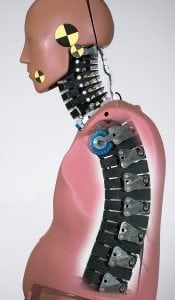In movies and television, whiplash is the go-to complaint for fraudulent insurance claims, but the reality is that it happens more than people would realize. Whiplash happens when the body moves forward faster than the head, creating a “whip” effect with the head rolling almost opposite of the body’s momentum. This exposes neck muscles to severe strain, resulting in tearing or worse.
Because whiplash is difficult to diagnose, it’s often downplayed or ignored. Severe cases can have nerve and spinal damage associated with them, but most cases are damaged muscle and sinew, which doesn’t usually show up well on CT or MRI scans.
Most whiplash injuries occur in moving traffic. A vehicle already in motion when hit by another vehicle (usually from behind) creates conditions in which people’s bodies in the slower vehicle are subjected to whiplash forces. Most whiplash injuries happen in lower-speed collisions and often do not involve airbag deployment.
Preventing Whiplash
The best way to prevent whiplash is to have properly adjusted head restraints in the vehicle. These “headrests” are made to cushion and protect the head during severe vehicle movements like those that happen in a crash. Paradoxically, as vehicles have gotten stiffer and safer in impacts, whiplash has become more prevalent.
 Head restraints should be adjusted to match the driver or passengers’ heads. The top of the head restraint should be positioned to be about as high as the top of the person’s head. The restraint should be pushed forward to within half an inch to one inch from the head (20-30mm). The closer the head restraint is to touching a person’s head, the better.
Head restraints should be adjusted to match the driver or passengers’ heads. The top of the head restraint should be positioned to be about as high as the top of the person’s head. The restraint should be pushed forward to within half an inch to one inch from the head (20-30mm). The closer the head restraint is to touching a person’s head, the better.
Further, the seat’s position can affect how well the head restraint cushions the head in a crash. The more upright the seat, the more upright the head restraint should be to match. Think of the back of the seat as a straight line that follows the line made by your head and spine.
Most whiplash claims come from passengers in the rear seating rather than from a driver or front passenger in a vehicle. This is because the rear seats are less likely to be adjusted and headrests are often left at their lowest position, passenger or not. Rear seat passengers should adjust their headrests to match their height whenever getting into a vehicle.
Every car subjected to the Euro NCAP crash tests is also evaluated for whiplash protection. Every vehicle subjected to the Insurance Institute For Highway Safety’s (IIHS) tests in the U.S. are also tested for whiplash protection in order to lower insurance claims for whiplash compensation. This is why most of today’s new car designs include often odd-looking head restraints such as the fat, forward-tilted restraints in Volvo vehicles. These are designed to offer better whiplash protection. Other designs include spring-loaded headrests, airbags, seatbelt pre-tensioning, and more.
Hopefully, using this information, you can mitigate whiplash injuries and keep your friends and family safe.







